Mental Health Well-Being and Dementia Care
VerifiedAdded on 2023/06/07
|10
|2621
|423
AI Summary
This article focuses on appraising the extent to which existing services support the older person with BPSD. It covers the knowledge of pathophysiology of dementia and BPSD, non-pharmacological strategies to manage behavioral symptoms, and service design project for older people with BPSD. The subject is Mental Health Well-Being and Dementia Care, and the course code is not mentioned. Get study material, solved assignments, essays, and dissertations on Desklib.
Contribute Materials
Your contribution can guide someone’s learning journey. Share your
documents today.
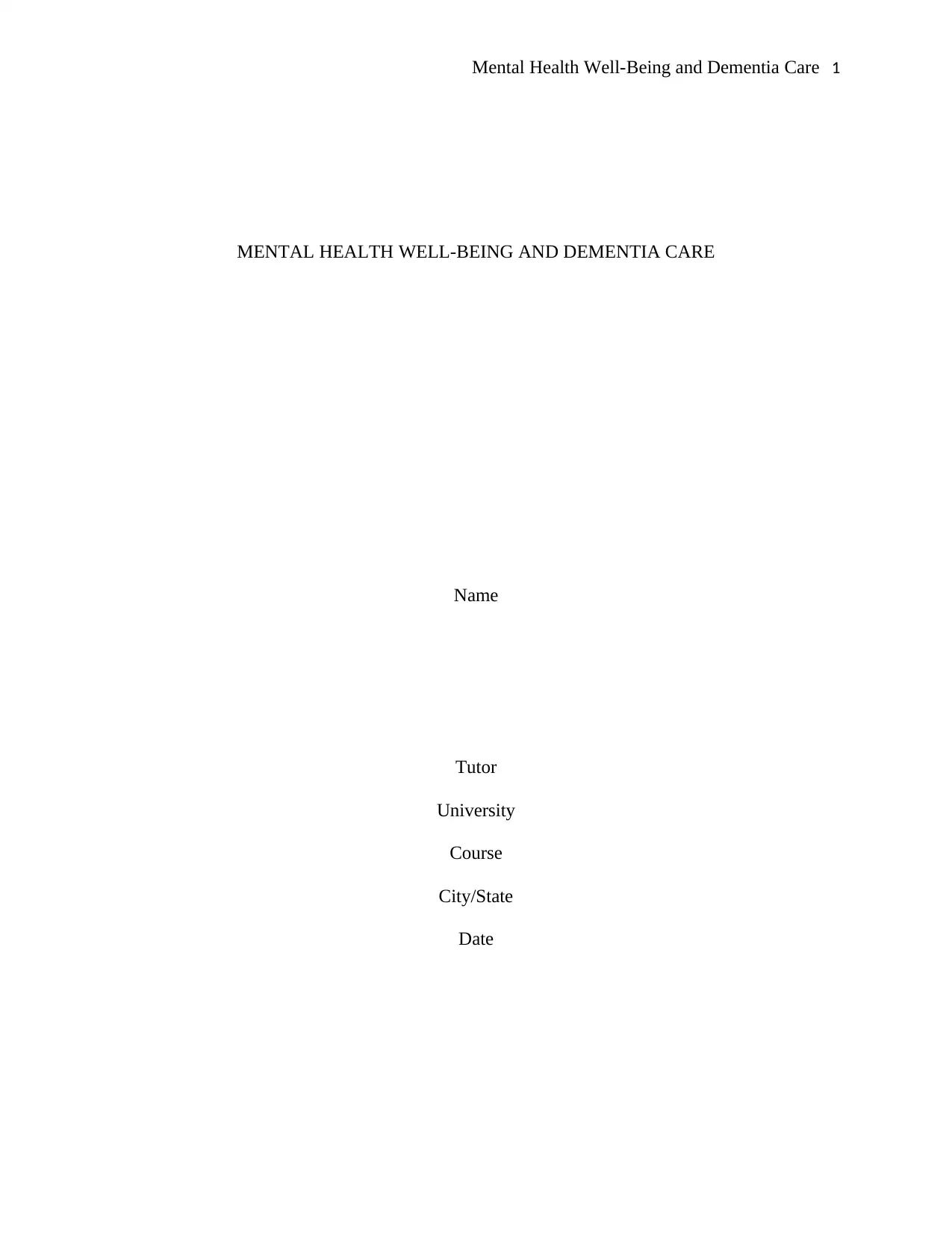
Mental Health Well-Being and Dementia Care 1
MENTAL HEALTH WELL-BEING AND DEMENTIA CARE
Name
Tutor
University
Course
City/State
Date
MENTAL HEALTH WELL-BEING AND DEMENTIA CARE
Name
Tutor
University
Course
City/State
Date
Secure Best Marks with AI Grader
Need help grading? Try our AI Grader for instant feedback on your assignments.
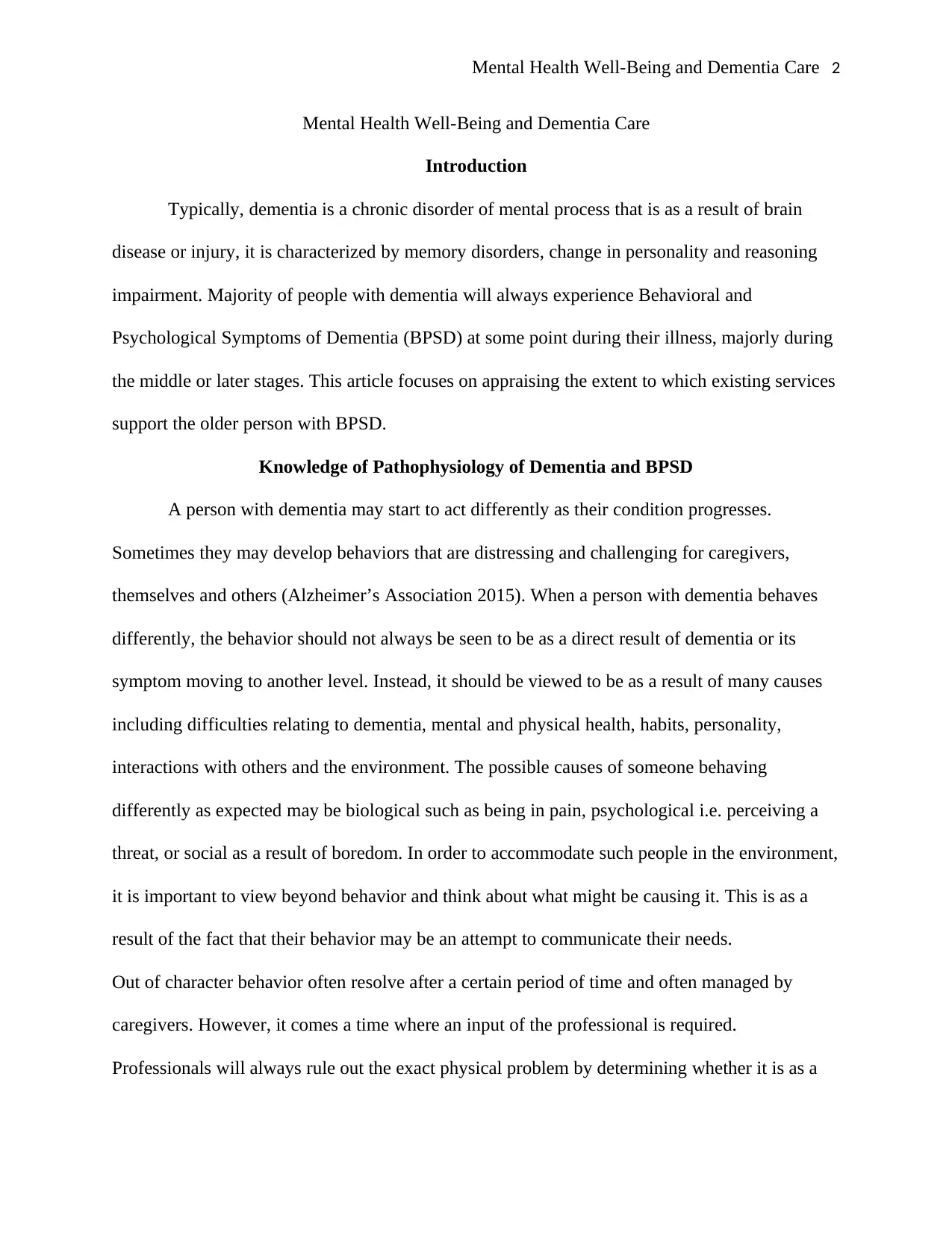
Mental Health Well-Being and Dementia Care 2
Mental Health Well-Being and Dementia Care
Introduction
Typically, dementia is a chronic disorder of mental process that is as a result of brain
disease or injury, it is characterized by memory disorders, change in personality and reasoning
impairment. Majority of people with dementia will always experience Behavioral and
Psychological Symptoms of Dementia (BPSD) at some point during their illness, majorly during
the middle or later stages. This article focuses on appraising the extent to which existing services
support the older person with BPSD.
Knowledge of Pathophysiology of Dementia and BPSD
A person with dementia may start to act differently as their condition progresses.
Sometimes they may develop behaviors that are distressing and challenging for caregivers,
themselves and others (Alzheimer’s Association 2015). When a person with dementia behaves
differently, the behavior should not always be seen to be as a direct result of dementia or its
symptom moving to another level. Instead, it should be viewed to be as a result of many causes
including difficulties relating to dementia, mental and physical health, habits, personality,
interactions with others and the environment. The possible causes of someone behaving
differently as expected may be biological such as being in pain, psychological i.e. perceiving a
threat, or social as a result of boredom. In order to accommodate such people in the environment,
it is important to view beyond behavior and think about what might be causing it. This is as a
result of the fact that their behavior may be an attempt to communicate their needs.
Out of character behavior often resolve after a certain period of time and often managed by
caregivers. However, it comes a time where an input of the professional is required.
Professionals will always rule out the exact physical problem by determining whether it is as a
Mental Health Well-Being and Dementia Care
Introduction
Typically, dementia is a chronic disorder of mental process that is as a result of brain
disease or injury, it is characterized by memory disorders, change in personality and reasoning
impairment. Majority of people with dementia will always experience Behavioral and
Psychological Symptoms of Dementia (BPSD) at some point during their illness, majorly during
the middle or later stages. This article focuses on appraising the extent to which existing services
support the older person with BPSD.
Knowledge of Pathophysiology of Dementia and BPSD
A person with dementia may start to act differently as their condition progresses.
Sometimes they may develop behaviors that are distressing and challenging for caregivers,
themselves and others (Alzheimer’s Association 2015). When a person with dementia behaves
differently, the behavior should not always be seen to be as a direct result of dementia or its
symptom moving to another level. Instead, it should be viewed to be as a result of many causes
including difficulties relating to dementia, mental and physical health, habits, personality,
interactions with others and the environment. The possible causes of someone behaving
differently as expected may be biological such as being in pain, psychological i.e. perceiving a
threat, or social as a result of boredom. In order to accommodate such people in the environment,
it is important to view beyond behavior and think about what might be causing it. This is as a
result of the fact that their behavior may be an attempt to communicate their needs.
Out of character behavior often resolve after a certain period of time and often managed by
caregivers. However, it comes a time where an input of the professional is required.
Professionals will always rule out the exact physical problem by determining whether it is as a
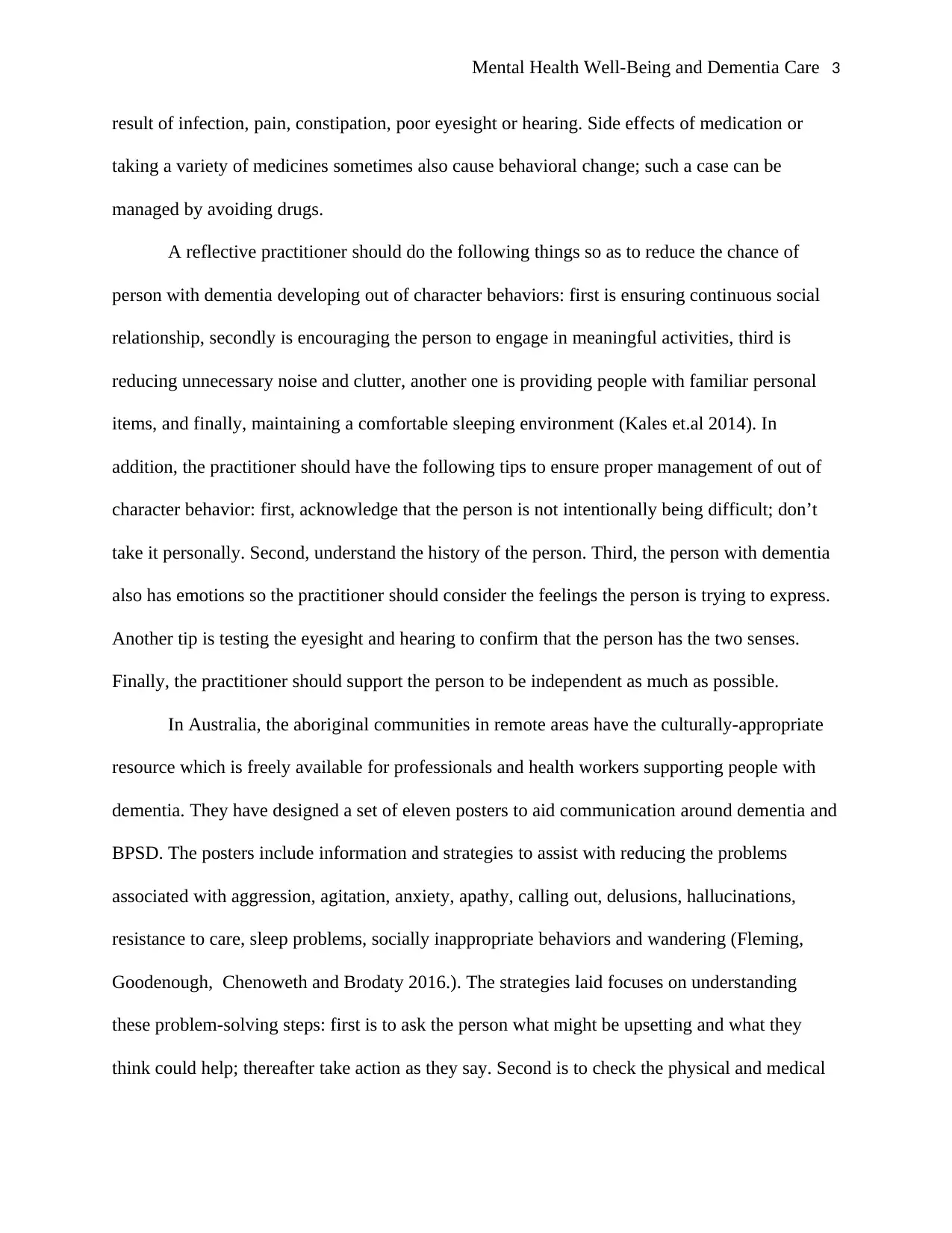
Mental Health Well-Being and Dementia Care 3
result of infection, pain, constipation, poor eyesight or hearing. Side effects of medication or
taking a variety of medicines sometimes also cause behavioral change; such a case can be
managed by avoiding drugs.
A reflective practitioner should do the following things so as to reduce the chance of
person with dementia developing out of character behaviors: first is ensuring continuous social
relationship, secondly is encouraging the person to engage in meaningful activities, third is
reducing unnecessary noise and clutter, another one is providing people with familiar personal
items, and finally, maintaining a comfortable sleeping environment (Kales et.al 2014). In
addition, the practitioner should have the following tips to ensure proper management of out of
character behavior: first, acknowledge that the person is not intentionally being difficult; don’t
take it personally. Second, understand the history of the person. Third, the person with dementia
also has emotions so the practitioner should consider the feelings the person is trying to express.
Another tip is testing the eyesight and hearing to confirm that the person has the two senses.
Finally, the practitioner should support the person to be independent as much as possible.
In Australia, the aboriginal communities in remote areas have the culturally-appropriate
resource which is freely available for professionals and health workers supporting people with
dementia. They have designed a set of eleven posters to aid communication around dementia and
BPSD. The posters include information and strategies to assist with reducing the problems
associated with aggression, agitation, anxiety, apathy, calling out, delusions, hallucinations,
resistance to care, sleep problems, socially inappropriate behaviors and wandering (Fleming,
Goodenough, Chenoweth and Brodaty 2016.). The strategies laid focuses on understanding
these problem-solving steps: first is to ask the person what might be upsetting and what they
think could help; thereafter take action as they say. Second is to check the physical and medical
result of infection, pain, constipation, poor eyesight or hearing. Side effects of medication or
taking a variety of medicines sometimes also cause behavioral change; such a case can be
managed by avoiding drugs.
A reflective practitioner should do the following things so as to reduce the chance of
person with dementia developing out of character behaviors: first is ensuring continuous social
relationship, secondly is encouraging the person to engage in meaningful activities, third is
reducing unnecessary noise and clutter, another one is providing people with familiar personal
items, and finally, maintaining a comfortable sleeping environment (Kales et.al 2014). In
addition, the practitioner should have the following tips to ensure proper management of out of
character behavior: first, acknowledge that the person is not intentionally being difficult; don’t
take it personally. Second, understand the history of the person. Third, the person with dementia
also has emotions so the practitioner should consider the feelings the person is trying to express.
Another tip is testing the eyesight and hearing to confirm that the person has the two senses.
Finally, the practitioner should support the person to be independent as much as possible.
In Australia, the aboriginal communities in remote areas have the culturally-appropriate
resource which is freely available for professionals and health workers supporting people with
dementia. They have designed a set of eleven posters to aid communication around dementia and
BPSD. The posters include information and strategies to assist with reducing the problems
associated with aggression, agitation, anxiety, apathy, calling out, delusions, hallucinations,
resistance to care, sleep problems, socially inappropriate behaviors and wandering (Fleming,
Goodenough, Chenoweth and Brodaty 2016.). The strategies laid focuses on understanding
these problem-solving steps: first is to ask the person what might be upsetting and what they
think could help; thereafter take action as they say. Second is to check the physical and medical
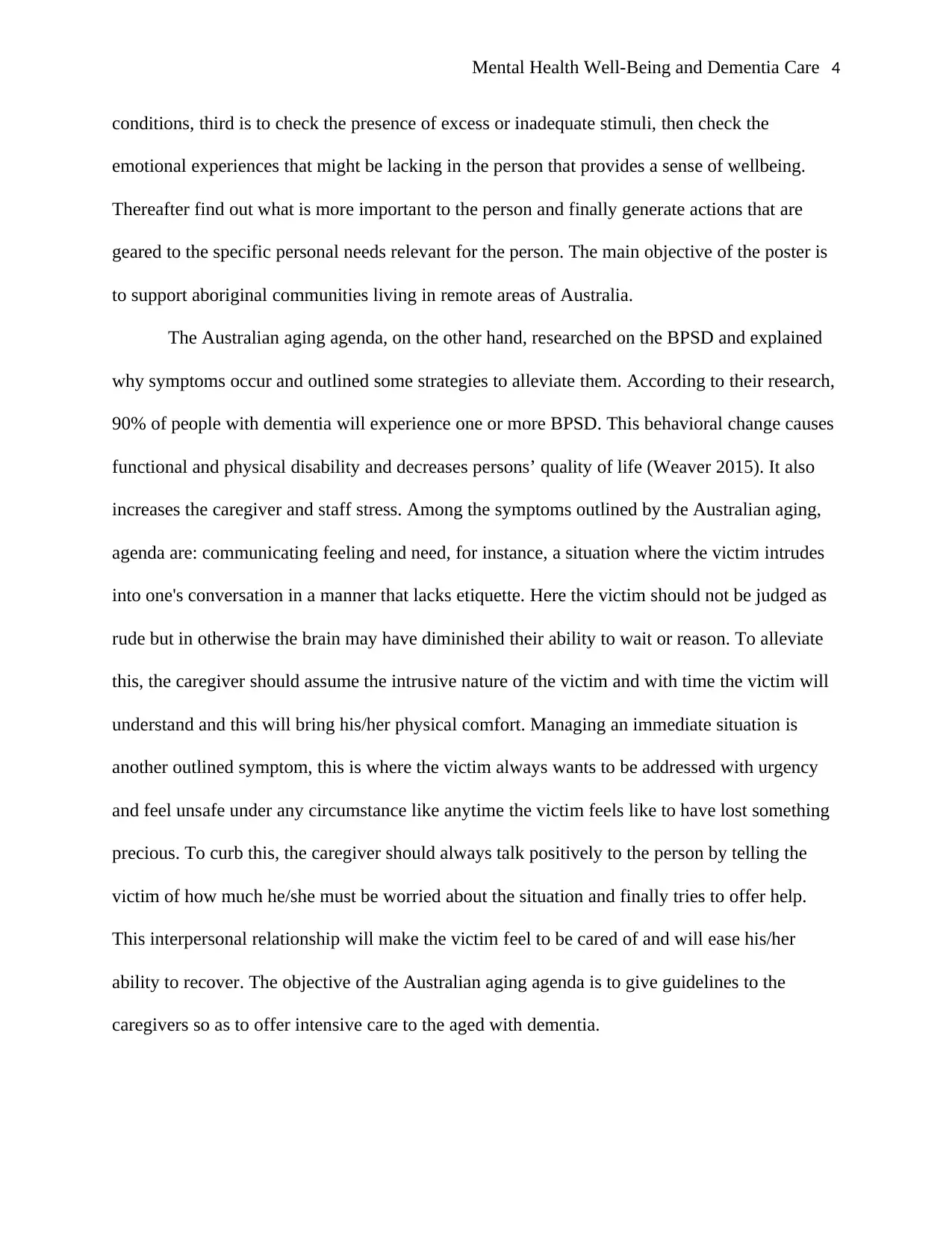
Mental Health Well-Being and Dementia Care 4
conditions, third is to check the presence of excess or inadequate stimuli, then check the
emotional experiences that might be lacking in the person that provides a sense of wellbeing.
Thereafter find out what is more important to the person and finally generate actions that are
geared to the specific personal needs relevant for the person. The main objective of the poster is
to support aboriginal communities living in remote areas of Australia.
The Australian aging agenda, on the other hand, researched on the BPSD and explained
why symptoms occur and outlined some strategies to alleviate them. According to their research,
90% of people with dementia will experience one or more BPSD. This behavioral change causes
functional and physical disability and decreases persons’ quality of life (Weaver 2015). It also
increases the caregiver and staff stress. Among the symptoms outlined by the Australian aging,
agenda are: communicating feeling and need, for instance, a situation where the victim intrudes
into one's conversation in a manner that lacks etiquette. Here the victim should not be judged as
rude but in otherwise the brain may have diminished their ability to wait or reason. To alleviate
this, the caregiver should assume the intrusive nature of the victim and with time the victim will
understand and this will bring his/her physical comfort. Managing an immediate situation is
another outlined symptom, this is where the victim always wants to be addressed with urgency
and feel unsafe under any circumstance like anytime the victim feels like to have lost something
precious. To curb this, the caregiver should always talk positively to the person by telling the
victim of how much he/she must be worried about the situation and finally tries to offer help.
This interpersonal relationship will make the victim feel to be cared of and will ease his/her
ability to recover. The objective of the Australian aging agenda is to give guidelines to the
caregivers so as to offer intensive care to the aged with dementia.
conditions, third is to check the presence of excess or inadequate stimuli, then check the
emotional experiences that might be lacking in the person that provides a sense of wellbeing.
Thereafter find out what is more important to the person and finally generate actions that are
geared to the specific personal needs relevant for the person. The main objective of the poster is
to support aboriginal communities living in remote areas of Australia.
The Australian aging agenda, on the other hand, researched on the BPSD and explained
why symptoms occur and outlined some strategies to alleviate them. According to their research,
90% of people with dementia will experience one or more BPSD. This behavioral change causes
functional and physical disability and decreases persons’ quality of life (Weaver 2015). It also
increases the caregiver and staff stress. Among the symptoms outlined by the Australian aging,
agenda are: communicating feeling and need, for instance, a situation where the victim intrudes
into one's conversation in a manner that lacks etiquette. Here the victim should not be judged as
rude but in otherwise the brain may have diminished their ability to wait or reason. To alleviate
this, the caregiver should assume the intrusive nature of the victim and with time the victim will
understand and this will bring his/her physical comfort. Managing an immediate situation is
another outlined symptom, this is where the victim always wants to be addressed with urgency
and feel unsafe under any circumstance like anytime the victim feels like to have lost something
precious. To curb this, the caregiver should always talk positively to the person by telling the
victim of how much he/she must be worried about the situation and finally tries to offer help.
This interpersonal relationship will make the victim feel to be cared of and will ease his/her
ability to recover. The objective of the Australian aging agenda is to give guidelines to the
caregivers so as to offer intensive care to the aged with dementia.
Secure Best Marks with AI Grader
Need help grading? Try our AI Grader for instant feedback on your assignments.
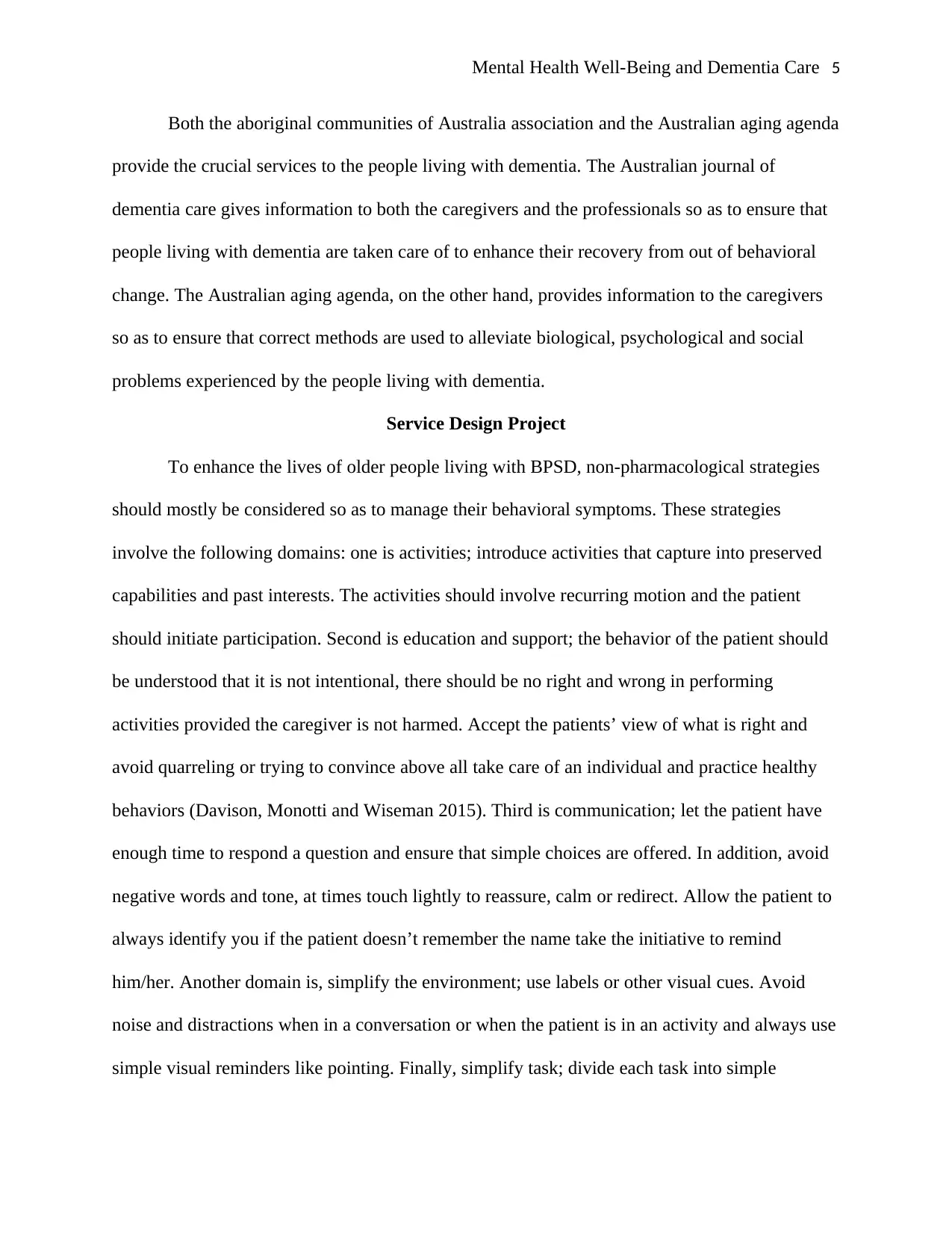
Mental Health Well-Being and Dementia Care 5
Both the aboriginal communities of Australia association and the Australian aging agenda
provide the crucial services to the people living with dementia. The Australian journal of
dementia care gives information to both the caregivers and the professionals so as to ensure that
people living with dementia are taken care of to enhance their recovery from out of behavioral
change. The Australian aging agenda, on the other hand, provides information to the caregivers
so as to ensure that correct methods are used to alleviate biological, psychological and social
problems experienced by the people living with dementia.
Service Design Project
To enhance the lives of older people living with BPSD, non-pharmacological strategies
should mostly be considered so as to manage their behavioral symptoms. These strategies
involve the following domains: one is activities; introduce activities that capture into preserved
capabilities and past interests. The activities should involve recurring motion and the patient
should initiate participation. Second is education and support; the behavior of the patient should
be understood that it is not intentional, there should be no right and wrong in performing
activities provided the caregiver is not harmed. Accept the patients’ view of what is right and
avoid quarreling or trying to convince above all take care of an individual and practice healthy
behaviors (Davison, Monotti and Wiseman 2015). Third is communication; let the patient have
enough time to respond a question and ensure that simple choices are offered. In addition, avoid
negative words and tone, at times touch lightly to reassure, calm or redirect. Allow the patient to
always identify you if the patient doesn’t remember the name take the initiative to remind
him/her. Another domain is, simplify the environment; use labels or other visual cues. Avoid
noise and distractions when in a conversation or when the patient is in an activity and always use
simple visual reminders like pointing. Finally, simplify task; divide each task into simple
Both the aboriginal communities of Australia association and the Australian aging agenda
provide the crucial services to the people living with dementia. The Australian journal of
dementia care gives information to both the caregivers and the professionals so as to ensure that
people living with dementia are taken care of to enhance their recovery from out of behavioral
change. The Australian aging agenda, on the other hand, provides information to the caregivers
so as to ensure that correct methods are used to alleviate biological, psychological and social
problems experienced by the people living with dementia.
Service Design Project
To enhance the lives of older people living with BPSD, non-pharmacological strategies
should mostly be considered so as to manage their behavioral symptoms. These strategies
involve the following domains: one is activities; introduce activities that capture into preserved
capabilities and past interests. The activities should involve recurring motion and the patient
should initiate participation. Second is education and support; the behavior of the patient should
be understood that it is not intentional, there should be no right and wrong in performing
activities provided the caregiver is not harmed. Accept the patients’ view of what is right and
avoid quarreling or trying to convince above all take care of an individual and practice healthy
behaviors (Davison, Monotti and Wiseman 2015). Third is communication; let the patient have
enough time to respond a question and ensure that simple choices are offered. In addition, avoid
negative words and tone, at times touch lightly to reassure, calm or redirect. Allow the patient to
always identify you if the patient doesn’t remember the name take the initiative to remind
him/her. Another domain is, simplify the environment; use labels or other visual cues. Avoid
noise and distractions when in a conversation or when the patient is in an activity and always use
simple visual reminders like pointing. Finally, simplify task; divide each task into simple
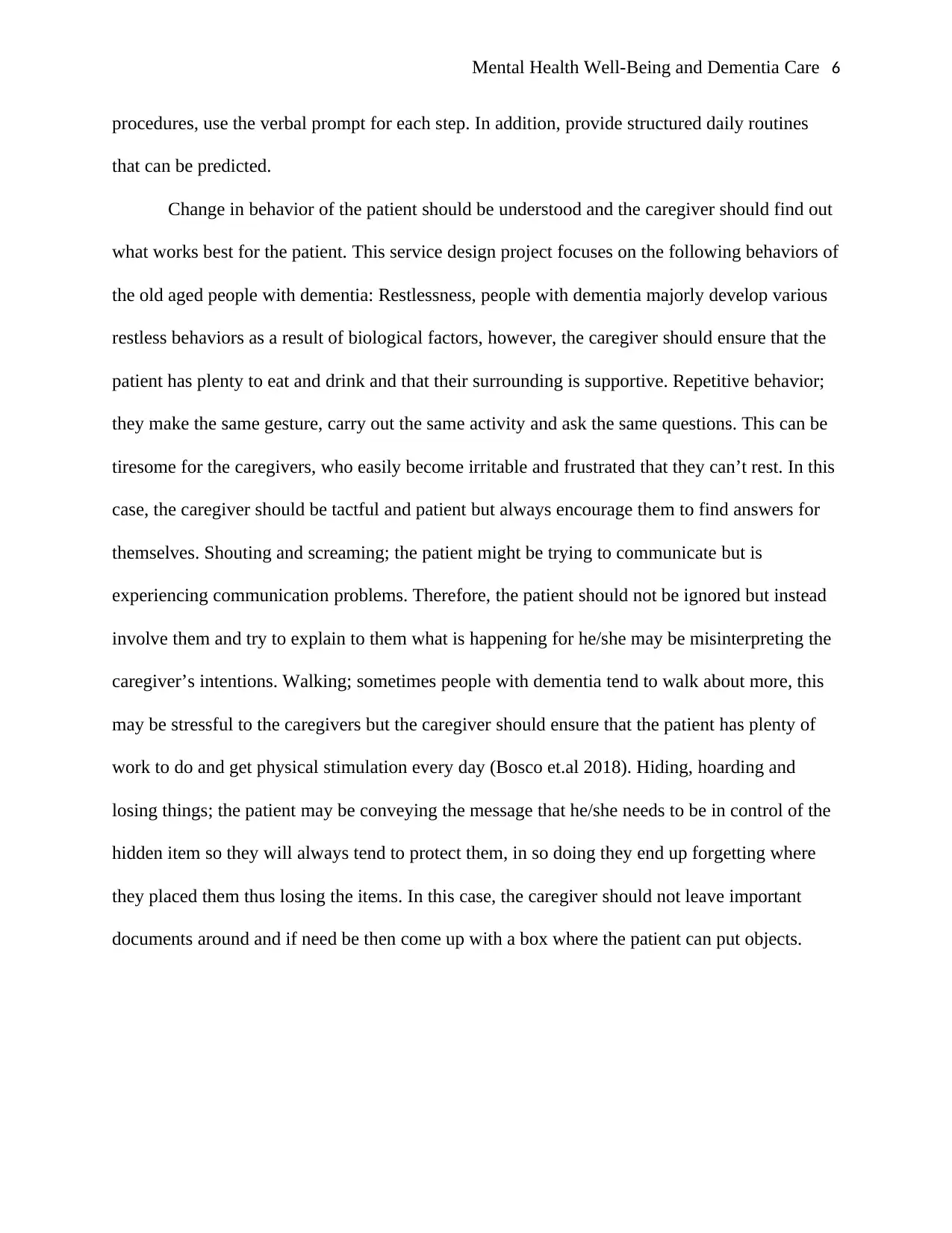
Mental Health Well-Being and Dementia Care 6
procedures, use the verbal prompt for each step. In addition, provide structured daily routines
that can be predicted.
Change in behavior of the patient should be understood and the caregiver should find out
what works best for the patient. This service design project focuses on the following behaviors of
the old aged people with dementia: Restlessness, people with dementia majorly develop various
restless behaviors as a result of biological factors, however, the caregiver should ensure that the
patient has plenty to eat and drink and that their surrounding is supportive. Repetitive behavior;
they make the same gesture, carry out the same activity and ask the same questions. This can be
tiresome for the caregivers, who easily become irritable and frustrated that they can’t rest. In this
case, the caregiver should be tactful and patient but always encourage them to find answers for
themselves. Shouting and screaming; the patient might be trying to communicate but is
experiencing communication problems. Therefore, the patient should not be ignored but instead
involve them and try to explain to them what is happening for he/she may be misinterpreting the
caregiver’s intentions. Walking; sometimes people with dementia tend to walk about more, this
may be stressful to the caregivers but the caregiver should ensure that the patient has plenty of
work to do and get physical stimulation every day (Bosco et.al 2018). Hiding, hoarding and
losing things; the patient may be conveying the message that he/she needs to be in control of the
hidden item so they will always tend to protect them, in so doing they end up forgetting where
they placed them thus losing the items. In this case, the caregiver should not leave important
documents around and if need be then come up with a box where the patient can put objects.
procedures, use the verbal prompt for each step. In addition, provide structured daily routines
that can be predicted.
Change in behavior of the patient should be understood and the caregiver should find out
what works best for the patient. This service design project focuses on the following behaviors of
the old aged people with dementia: Restlessness, people with dementia majorly develop various
restless behaviors as a result of biological factors, however, the caregiver should ensure that the
patient has plenty to eat and drink and that their surrounding is supportive. Repetitive behavior;
they make the same gesture, carry out the same activity and ask the same questions. This can be
tiresome for the caregivers, who easily become irritable and frustrated that they can’t rest. In this
case, the caregiver should be tactful and patient but always encourage them to find answers for
themselves. Shouting and screaming; the patient might be trying to communicate but is
experiencing communication problems. Therefore, the patient should not be ignored but instead
involve them and try to explain to them what is happening for he/she may be misinterpreting the
caregiver’s intentions. Walking; sometimes people with dementia tend to walk about more, this
may be stressful to the caregivers but the caregiver should ensure that the patient has plenty of
work to do and get physical stimulation every day (Bosco et.al 2018). Hiding, hoarding and
losing things; the patient may be conveying the message that he/she needs to be in control of the
hidden item so they will always tend to protect them, in so doing they end up forgetting where
they placed them thus losing the items. In this case, the caregiver should not leave important
documents around and if need be then come up with a box where the patient can put objects.
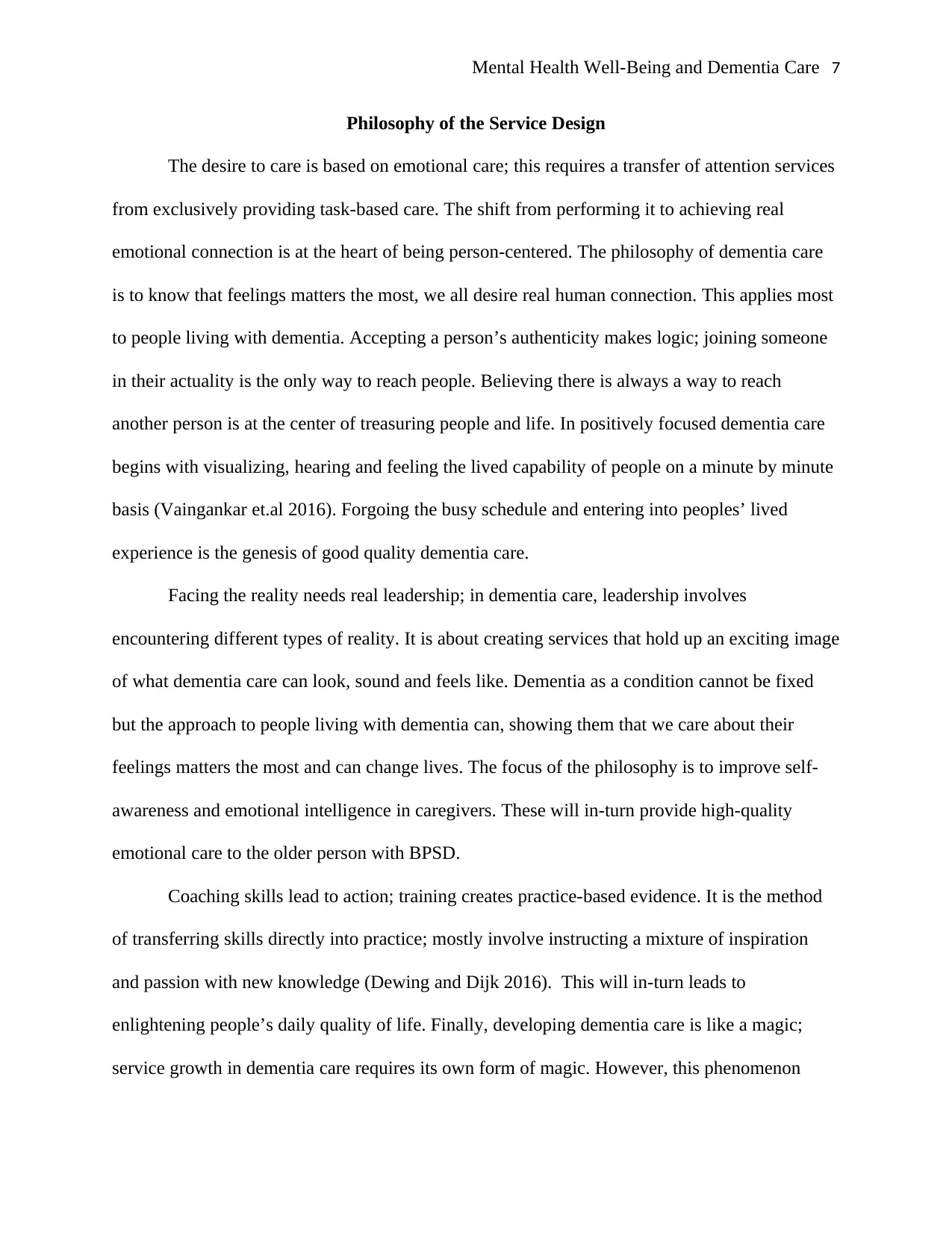
Mental Health Well-Being and Dementia Care 7
Philosophy of the Service Design
The desire to care is based on emotional care; this requires a transfer of attention services
from exclusively providing task-based care. The shift from performing it to achieving real
emotional connection is at the heart of being person-centered. The philosophy of dementia care
is to know that feelings matters the most, we all desire real human connection. This applies most
to people living with dementia. Accepting a person’s authenticity makes logic; joining someone
in their actuality is the only way to reach people. Believing there is always a way to reach
another person is at the center of treasuring people and life. In positively focused dementia care
begins with visualizing, hearing and feeling the lived capability of people on a minute by minute
basis (Vaingankar et.al 2016). Forgoing the busy schedule and entering into peoples’ lived
experience is the genesis of good quality dementia care.
Facing the reality needs real leadership; in dementia care, leadership involves
encountering different types of reality. It is about creating services that hold up an exciting image
of what dementia care can look, sound and feels like. Dementia as a condition cannot be fixed
but the approach to people living with dementia can, showing them that we care about their
feelings matters the most and can change lives. The focus of the philosophy is to improve self-
awareness and emotional intelligence in caregivers. These will in-turn provide high-quality
emotional care to the older person with BPSD.
Coaching skills lead to action; training creates practice-based evidence. It is the method
of transferring skills directly into practice; mostly involve instructing a mixture of inspiration
and passion with new knowledge (Dewing and Dijk 2016). This will in-turn leads to
enlightening people’s daily quality of life. Finally, developing dementia care is like a magic;
service growth in dementia care requires its own form of magic. However, this phenomenon
Philosophy of the Service Design
The desire to care is based on emotional care; this requires a transfer of attention services
from exclusively providing task-based care. The shift from performing it to achieving real
emotional connection is at the heart of being person-centered. The philosophy of dementia care
is to know that feelings matters the most, we all desire real human connection. This applies most
to people living with dementia. Accepting a person’s authenticity makes logic; joining someone
in their actuality is the only way to reach people. Believing there is always a way to reach
another person is at the center of treasuring people and life. In positively focused dementia care
begins with visualizing, hearing and feeling the lived capability of people on a minute by minute
basis (Vaingankar et.al 2016). Forgoing the busy schedule and entering into peoples’ lived
experience is the genesis of good quality dementia care.
Facing the reality needs real leadership; in dementia care, leadership involves
encountering different types of reality. It is about creating services that hold up an exciting image
of what dementia care can look, sound and feels like. Dementia as a condition cannot be fixed
but the approach to people living with dementia can, showing them that we care about their
feelings matters the most and can change lives. The focus of the philosophy is to improve self-
awareness and emotional intelligence in caregivers. These will in-turn provide high-quality
emotional care to the older person with BPSD.
Coaching skills lead to action; training creates practice-based evidence. It is the method
of transferring skills directly into practice; mostly involve instructing a mixture of inspiration
and passion with new knowledge (Dewing and Dijk 2016). This will in-turn leads to
enlightening people’s daily quality of life. Finally, developing dementia care is like a magic;
service growth in dementia care requires its own form of magic. However, this phenomenon
Paraphrase This Document
Need a fresh take? Get an instant paraphrase of this document with our AI Paraphraser
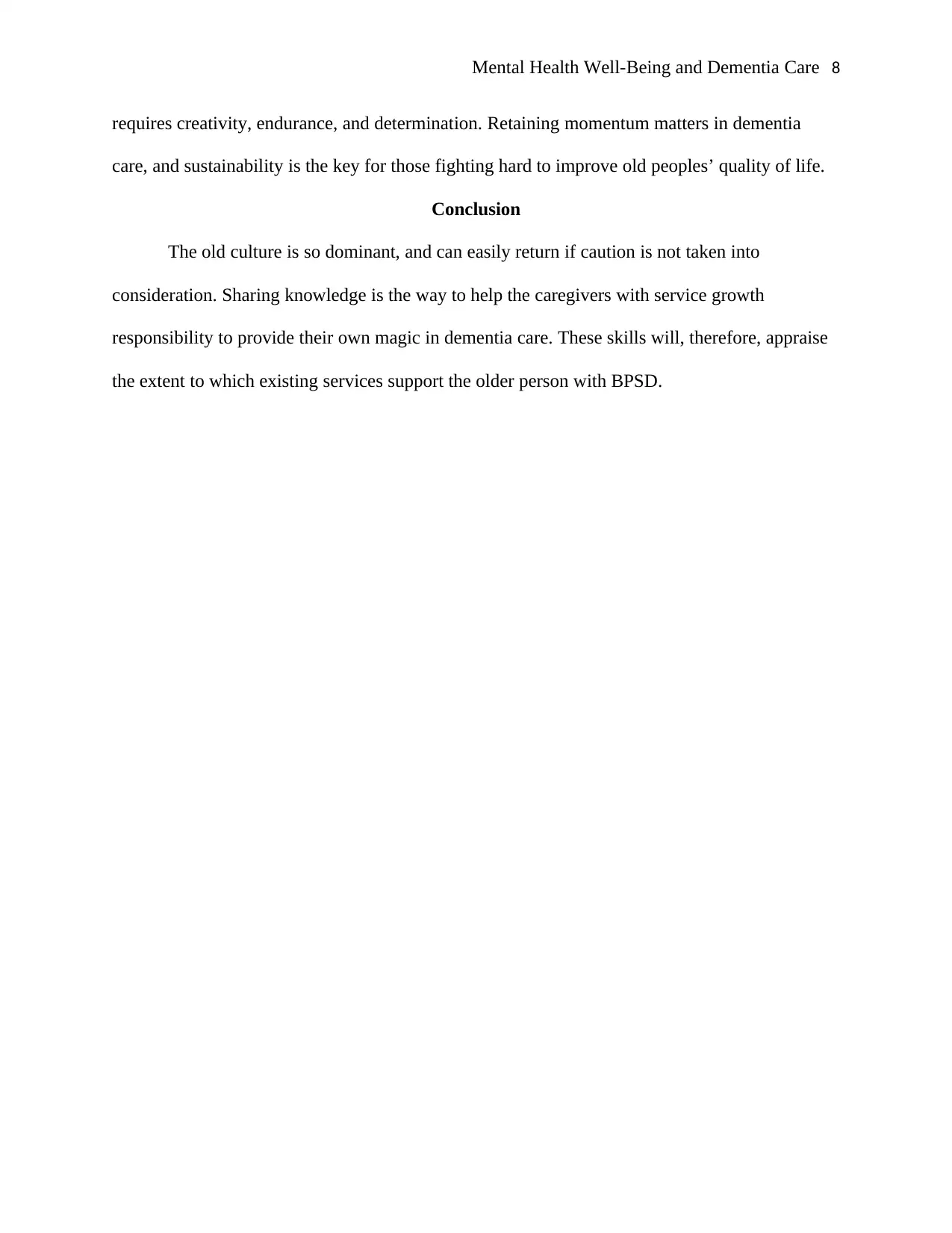
Mental Health Well-Being and Dementia Care 8
requires creativity, endurance, and determination. Retaining momentum matters in dementia
care, and sustainability is the key for those fighting hard to improve old peoples’ quality of life.
Conclusion
The old culture is so dominant, and can easily return if caution is not taken into
consideration. Sharing knowledge is the way to help the caregivers with service growth
responsibility to provide their own magic in dementia care. These skills will, therefore, appraise
the extent to which existing services support the older person with BPSD.
requires creativity, endurance, and determination. Retaining momentum matters in dementia
care, and sustainability is the key for those fighting hard to improve old peoples’ quality of life.
Conclusion
The old culture is so dominant, and can easily return if caution is not taken into
consideration. Sharing knowledge is the way to help the caregivers with service growth
responsibility to provide their own magic in dementia care. These skills will, therefore, appraise
the extent to which existing services support the older person with BPSD.
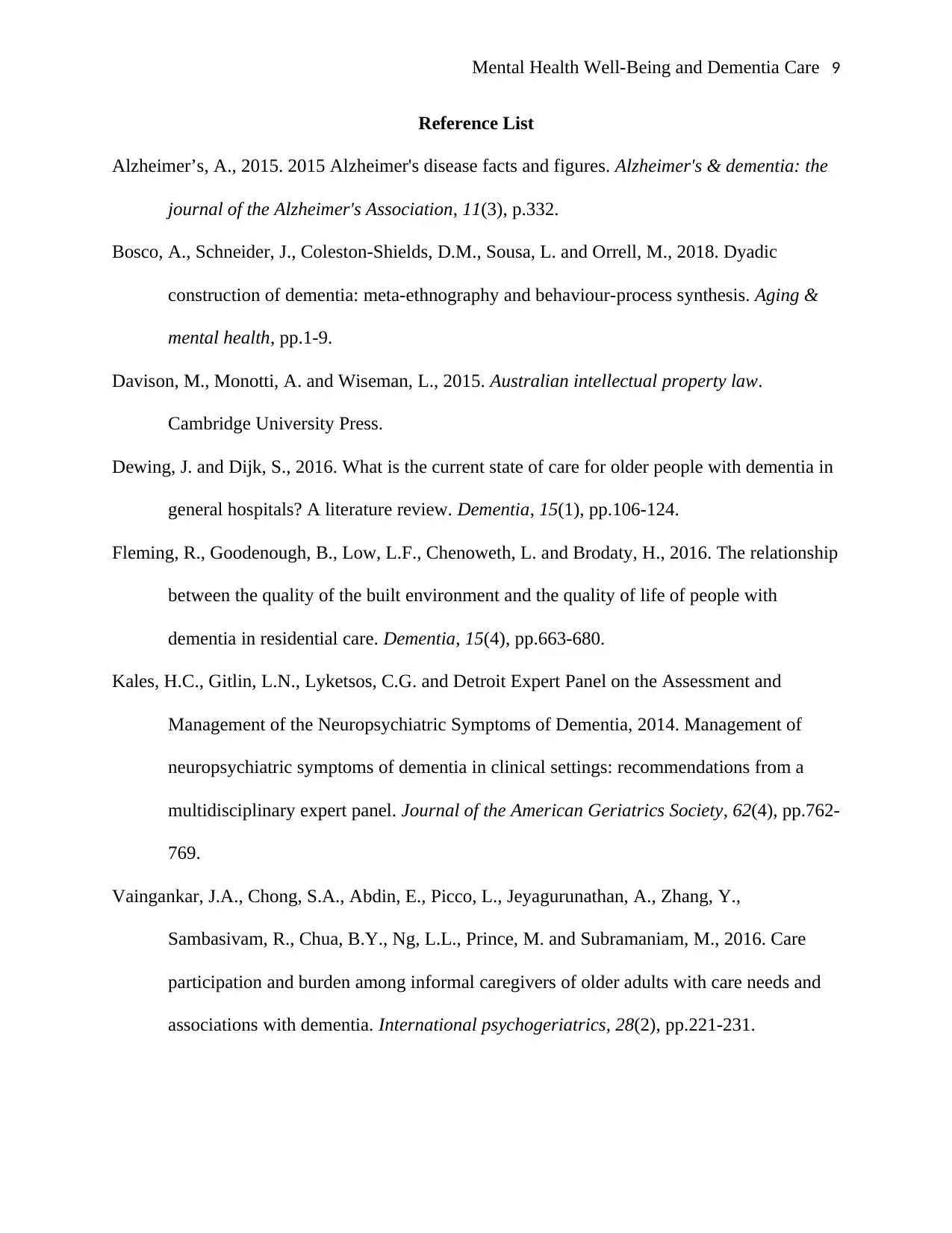
Mental Health Well-Being and Dementia Care 9
Reference List
Alzheimer’s, A., 2015. 2015 Alzheimer's disease facts and figures. Alzheimer's & dementia: the
journal of the Alzheimer's Association, 11(3), p.332.
Bosco, A., Schneider, J., Coleston-Shields, D.M., Sousa, L. and Orrell, M., 2018. Dyadic
construction of dementia: meta-ethnography and behaviour-process synthesis. Aging &
mental health, pp.1-9.
Davison, M., Monotti, A. and Wiseman, L., 2015. Australian intellectual property law.
Cambridge University Press.
Dewing, J. and Dijk, S., 2016. What is the current state of care for older people with dementia in
general hospitals? A literature review. Dementia, 15(1), pp.106-124.
Fleming, R., Goodenough, B., Low, L.F., Chenoweth, L. and Brodaty, H., 2016. The relationship
between the quality of the built environment and the quality of life of people with
dementia in residential care. Dementia, 15(4), pp.663-680.
Kales, H.C., Gitlin, L.N., Lyketsos, C.G. and Detroit Expert Panel on the Assessment and
Management of the Neuropsychiatric Symptoms of Dementia, 2014. Management of
neuropsychiatric symptoms of dementia in clinical settings: recommendations from a
multidisciplinary expert panel. Journal of the American Geriatrics Society, 62(4), pp.762-
769.
Vaingankar, J.A., Chong, S.A., Abdin, E., Picco, L., Jeyagurunathan, A., Zhang, Y.,
Sambasivam, R., Chua, B.Y., Ng, L.L., Prince, M. and Subramaniam, M., 2016. Care
participation and burden among informal caregivers of older adults with care needs and
associations with dementia. International psychogeriatrics, 28(2), pp.221-231.
Reference List
Alzheimer’s, A., 2015. 2015 Alzheimer's disease facts and figures. Alzheimer's & dementia: the
journal of the Alzheimer's Association, 11(3), p.332.
Bosco, A., Schneider, J., Coleston-Shields, D.M., Sousa, L. and Orrell, M., 2018. Dyadic
construction of dementia: meta-ethnography and behaviour-process synthesis. Aging &
mental health, pp.1-9.
Davison, M., Monotti, A. and Wiseman, L., 2015. Australian intellectual property law.
Cambridge University Press.
Dewing, J. and Dijk, S., 2016. What is the current state of care for older people with dementia in
general hospitals? A literature review. Dementia, 15(1), pp.106-124.
Fleming, R., Goodenough, B., Low, L.F., Chenoweth, L. and Brodaty, H., 2016. The relationship
between the quality of the built environment and the quality of life of people with
dementia in residential care. Dementia, 15(4), pp.663-680.
Kales, H.C., Gitlin, L.N., Lyketsos, C.G. and Detroit Expert Panel on the Assessment and
Management of the Neuropsychiatric Symptoms of Dementia, 2014. Management of
neuropsychiatric symptoms of dementia in clinical settings: recommendations from a
multidisciplinary expert panel. Journal of the American Geriatrics Society, 62(4), pp.762-
769.
Vaingankar, J.A., Chong, S.A., Abdin, E., Picco, L., Jeyagurunathan, A., Zhang, Y.,
Sambasivam, R., Chua, B.Y., Ng, L.L., Prince, M. and Subramaniam, M., 2016. Care
participation and burden among informal caregivers of older adults with care needs and
associations with dementia. International psychogeriatrics, 28(2), pp.221-231.

Mental Health Well-Being and Dementia Care 10
Weaver, J. (2015). Dementia: Empathy is key to alleviating worrying behaviours. Australian
Ageing Agenda, (May/June 2015), 48.
Weaver, J. (2015). Dementia: Empathy is key to alleviating worrying behaviours. Australian
Ageing Agenda, (May/June 2015), 48.
1 out of 10
Related Documents
Your All-in-One AI-Powered Toolkit for Academic Success.
+13062052269
info@desklib.com
Available 24*7 on WhatsApp / Email
![[object Object]](/_next/static/media/star-bottom.7253800d.svg)
Unlock your academic potential
© 2024 | Zucol Services PVT LTD | All rights reserved.




